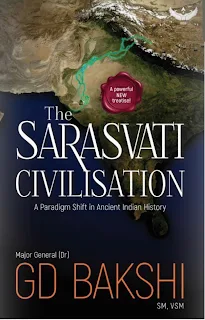Author: Maj General Dr GD Bakshi
In secondary school history class, we were taught to believe that civilisation developed circa 1500 BCE around the Indus River. Then came mighty learned men from the Steppe Land on horsebacks to bring knowledge and wisdom to this region. The original inhabitants of this region ran helter-skelter, crossing the Vindhya Hills to root themselves in the Southern part of the subcontinent. We vaguely remember being told about the Aryan Invasion Theory and the clear demarcation between the Northern part of India and the South.
.
Later in life, we were exposed to Mahabharata, Ramayana and Bhagavad Gita. What was taught as mythological tales, we later found out, was actually backed with scientific facts. For starters, the birth dates of specific icons could be fact-checked as their birthdates were described in relation to astronomical positions. These scriptures also illustrate a lush culture along the banks of a massive river with a width of up to 6-8km with torrents of glacier water, traversing 4,600km from the Himalayas. The scientific calculations of this event place it somewhere 5,000 to 6,000 years before the present, i.e. ~3000 BCE. It is also said to bear water from Yamuna and Sutlej.
Bunkum, say the Western historians and leftist-minded members of the academia. Even modern-day Indian historians, among which Romila Thapar is infamous, concur with the theory that Aryan Invasion is true and the Sarasvati River did not exist.
Since the 1970s, with the aid of satellite images, traces the presence of a large basin reminiscent of a dried-up river. We know Carbon C14 dating on archaeological finds is not easy. However, local archaeologists are confident that Indus-Saraswati could be as old as 9,500 years before the present. If that is true, the Indus-Saraswati must be the cradle of civilisation, preceding the Tigris-Euphrates one.
 |
| The Dancing Girl of Mohenjo-Daro Indus Valley Civilisation ?2300-1750 BCE. |
Archaeological excavation reveals they find spoils away from Indus, nearer to Saraswati River's 'mythical' placement. Perhaps, the descriptions of Rig Veda, about the glory of Saraswati and the glorious kingdom surrounding Saraswati, actually denote Harappa civilisation. Is it not amazing that cultural traditions, as seen in statues from Mohinjo-Daro and Harappa, are still practised in the sub-continent even today?
Geologists suggest massive technotic plate movements that made the Yamuna and Salrej rivers change course between 4,600 and 2,700 years ago. Only during monsoons the Sarswati used to drain. Later, Saraswati water went underground, leaving pockets of pools. The Ganges became more prominent as Yamuna and Sutlej brought in a glacial stream of water. So, the Saraswathi described in Rig Veda corresponds to the lifeline of the scriptures.
If the Aryans did indeed move into Indus/Sarasvathi Valley, we would have been moving into a desiccated plain where the rivers had run dry by 1500 BCE. If the Aryans brought in culture, archaeological dating of Mohinjo-Daro and Harappa buildings would pre-date this timeline.
Now, who are these Aryans? Are they alien immigrants or indigenous to the area? Genetic tracking via maternal and paternal DNA to differentiate Aryans and Dravidians and to prove migration into India does not seem convincing. Its methodology is also allegedly flawed. Its sample failed to include subjects from essential groups. There is proof Aryans were local people who had evolved all through the Paleolithic (Stone Age) through to the Neolithic and Chalcolithic (Bronze) stages of civilisation. They had become farmers and domesticated plants and animals.
In fact, many now believe that, just like there was an 'Out of Africa' theory to explain the migration of primitive homosapiens, there is a convincing case for an 'Out of India' deduction to expanding human civilisation. There is ample proof that eco-catastrophe made them out of Indus/Saraswati.
It looks like the age-old Aryan Invasion Theory propagated by Max Müller, and Mortimer Wheeler will get the boot. There is evidence of genocide to convince us that Aryans butchered cultured Dravidians and drove them southwardly. The theory that came out later, Indo-Aryan Migration, says that Aryans supposedly came in droves to a desert land.
The colonial masters probably introduced the Aryan Invasion Theory to convince their subjects that they had indeed been colonised for aeons. In a way, it was their justification to rule over India and 'civilise' them. The British left long ago, but the push to maintain the status quo is ever so strong. Detractors have, in their sleeves, many deceptive ways to prove their point of Europe and Central Asia being the cradle of civilisation, which forms the basis of Judeo-Christian ideology, not Hinduism, not India. It is peculiar that features seen in the dancing girl of Mahinjo-Daro, like the multiple bangle adornment and the vermillion marking at the parting of the hair characteristic of married women in the subcontinent, are still present today.
It drives home the point that Indian or Hindu culture, as that was how the way of life practised in this part of the world was referred to, still stand tall despite all the external forces and invaders that permeated and tried to dominate over theirs.
[P.S. The analysis of DNA samples extracted from the skeleton of a woman buried in Rakhigarhi, Haryana, four to five millennia ago rejected the theory of Steppe pastoral or ancient Iranian farmers as a source of ancestry to the Harappan population. It demolished the hypothesis about mass human migration during Harappan time from outside south Asian genes. The sample had traces of genes of Iranian lineage. Since the pieces were as old as 11,000 to 12,000 years ago, it is way before Harappan.]





